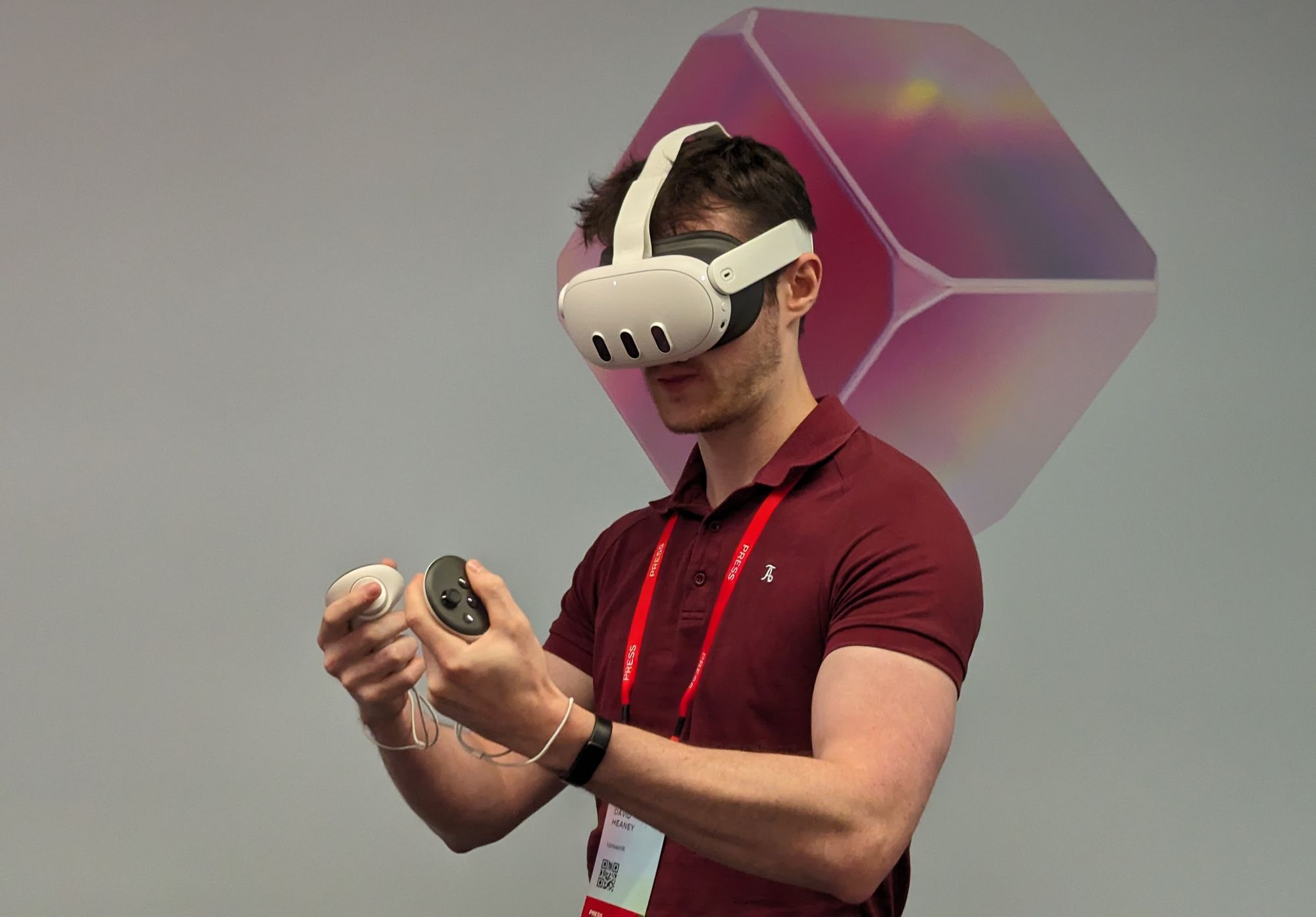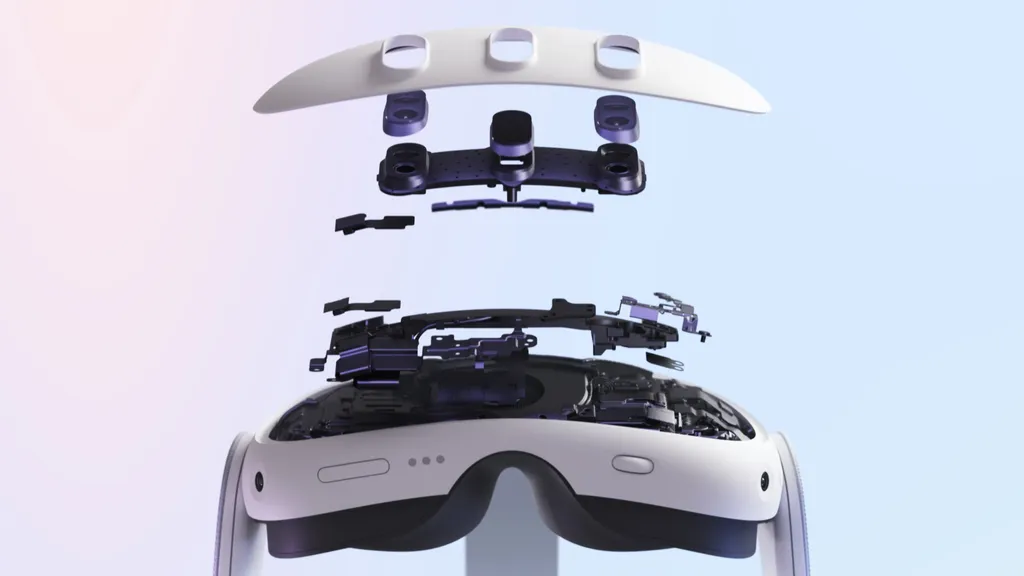Meta just opened preorders for Quest 3, set to be the most powerful standalone headset yet when it ships in October. Here’s a detailed rundown of its specifications and features and how those compare to other headsets.
Of course, on-paper specification sheets don’t tell the whole story, so you should also read our hands-on impressions.

Quest 3 Specs vs Quest 2 vs Quest Pro
Quest 3's specs significantly exceed Quest 2 with no regressions, and in most ways even surpass Quest Pro despite starting at half the price.
| Quest 2 | Quest Pro | Quest 3 | |
| Launch | Late 2020 | Late 2022 | Late 2023 |
| Lens Type | Fresnel | Pancake | Pancake |
| Field of View | 89-96° | 106° | 110° |
| Lens Separation | 58mm / 63mm / 68mm | 58mm–70mm | 58mm–70mm |
| Supported IPDs | 56mm-60mm / 61mm-65mm / 66-70mm |
55mm–75mm | 53mm–75mm |
| Depth Adjust | ❌ | ✅ | ✅ |
| Display Type | Single LCD | Dual QD-LCD | Dual LCD |
| Pixels Per Eye | ~1680×1870 (est) | 1800×1920 | 2064×2208 |
| Angular Resolution | 21 PPD | 22 PPD | 25 PPD |
| Local Dimming | ❌ | ✅ | ❌ |
| Max Refresh Rate | 120Hz | 90Hz | 120Hz |
| Chipset | Snapdragon XR2 Gen 1 (7nm) |
Snapdragon XR2+ Gen 1 (7nm) |
Snapdragon XR2 Gen 2 (4nm) |
| RAM | 6GB | 12GB | 8GB |
| 6GHz Wi-Fi | ❌ | ✅ | ✅ |
| Passthrough | Greyscale Low Res |
Colorized Greyscale Medium Res |
True Color High Res |
| Depth Sensing | ❌ | ❌ | ✅ |
| Battery Location | Visor | Rear Padding | Visor |
| Eye Tracking | ❌ | ✅ | ❌ |
| Face Tracking | ❌ | ✅ | ❌ |
| Controllers | Touch Tracking Rings Basic Haptics |
Touch Pro Self-Tracking TruTouch Haptics |
Touch Plus Ringless TruTouch Haptics |
| Pricing | $300 (128GB) $350 (256GB) |
$1000 (256GB) | $500 (128GB) $650 (512GB) |
Quest Pro is still the only Meta option for local dimming, eye tracking, and face tracking. But Quest 3 has a twice as powerful GPU, higher resolution, higher max refresh rate, 3x the color passthrough pixels, and a depth projector for 3D environment meshing and improved hand tracking.
Quest 3 Specs vs Apple Vision Pro
While Apple Vision Pro is a much higher end device with a starting price seven times higher, Quest 3's specs actually hold up fairly well.
| Meta Quest 3 | Apple Vision Pro | |
| Launch | Late 2023 | Early 2024 |
| Operating System | Meta's Android Fork | visionOS |
| IPD Adjustment | Manual | Fully Automatic |
| Display Type | LCD | Micro-OLED |
| Total Pixels | 9.1 million | 23 million |
| HDR | ❌ | ✅ |
| Refresh Rates | 72/80/90/120 Hz | 90/96 Hz |
| Chipset | Qualcomm Snapdragon XR2 Gen 2 (4nm) |
Apple M2 (5nm) |
| Color Cameras | 2x 4MP | 2x High-Res |
| Depth Sensing | ✅ | ✅ |
| Eye Tracking | ❌ | ✅ |
| Face Tracking | ❌ | ✅ |
| Battery Location | Visor | Tethered External |
| Battery Life | 2-3 hours | 2 hours |
| Front Display | ❌ | ✅ |
| Authentication | Pattern | OpticID |
| Tracked Controllers | ✅ | ❌ |
| Starting Price | $500 | $3500 |
At a much more accessible price, Quest 3 still promises color passthrough good enough to read your phone, a slim visor with pancake lenses, and hardware depth sensing for 3D environment meshing and high-quality hand tracking. And unlike Vision Pro, it has tracked controllers and doesn't need an external battery.
However, Vision Pro has OLED microdisplays with more than twice the number of pixels, a more powerful chipset, eye tracking, face tracking, automatic IPD adjustment, OpticID, and the EyeSight front display. It can also run most iPhone and iPad apps from the App Store as floating panels, and developers can even offer cross-buy.
Quest 3 Specs vs Pico 4
ByteDance's Pico 4 launched last year to consumers in Europe and Asia boasting improved hardware compared to Quest 2, including a slimmer design enabled by pancake lenses which also have a wider field of view.
However, Pico 4 still uses the original Snapdragon XR2 Gen 1, whereas Quest 3 is the first headset with the new XR2 Gen 2. Further, Quest 3 has active depth sensing for 3D environment meshing and improved hand tracking, while Pico 4 only features 2D cameras.
| Quest 2 | Pico 4 | Quest 3 | |
| Launch | Late 2020 | Late 2022 | Late 2023 |
| Lens Type | Fresnel | Pancake | Pancake |
| Field of View | 89-96° × 96° | 105° × 105° | 110°× 96° |
| Lens Separation | 3-step | Continuous | Continuous |
| Depth Adjustment | ❌ | ❌ | ✅ |
| Display Type | Single LCD | Dual LCD | Dual LCD |
| Pixels Per Eye | ~1680×1870 (est) | 2160×2160 | 2064×2208 |
| Angular Resolution | 21 PPD | 21 PPD | 25 PPD |
| Max Refresh Rate | 120Hz | 90Hz | 120Hz (experimental) |
| Chipset | Snapdragon XR2 Gen 1 (7nm) |
Snapdragon XR2 Gen 1 (7nm) |
Snapdragon XR2 Gen 2 (4nm) |
| RAM | 6GB | 8GB | 8GB |
| Passthrough | Low Res Greyscale (Depth Correct) |
Color High Res (Not Depth Correct) |
Color High Res (Depth Correct) |
| Depth Sensing | ❌ | ❌ | ✅ |
| Strap Type | Flimsy Cloth (Replaceable) |
Semi-Rigid Plastic (Not Replaceable) |
Flimsy Cloth (Replaceable) |
| 6GHz Wi-Fi | ❌ | ❌ | ✅ |
| Battery Location | Visor | Rear Padding | Visor |
| Battery Life | 2 hours | 2 hours | 1.5-2.9 hours |
| Controllers | Rings Basic Haptics |
Arcs HyperSense Haptics |
Ringless TruTouch Haptics |
| Pricing | €350 (128GB) €400 (256GB) |
€430 (128GB) €500 (256GB) |
€550 (128GB) €700 (512GB) |
However, Pico 4 still has its own advantages over Quest 3: better weight distribution thanks to its battery being in the rear padding, and a taller field of view.
Quest 3 Specs vs Original Oculus Quest
Of course, no specs comparison would be complete without including the original Oculus Quest, the device that redefined VR over four years ago.
| Oculus Quest | Quest 2 | Quest 3 | |
| Launch | Mid 2019 | Late 2020 | Late 2023 |
| Lens Type | Fresnel | Fresnel | Pancake |
| Field of View | No Official Figure | 89-96° | 110° |
| Lens Separation | 58mm–72mm | 58mm / 63mm / 68mm | 58mm–72mm |
| Supported IPDs | 56mm–74mm | 56mm-60mm / 61mm-65mm / 66-70mm |
53mm–75mm |
| Depth Adjustment | ❌ | ❌ | ✅ |
| Display Type | Dual OLED | Single LCD | Dual LCD |
| Pixels Per Eye | PenTile 1440×1600 | RGB ~1680×1870 (est) | RGB 2064×2208 |
| Angular Resolution | ~16 PPD | 21 PPD | 25 PPD |
| Max Refresh Rate | 72Hz | 120Hz | 120Hz (experimental) |
| Chipset | Snapdragon 835 (10nm) |
Snapdragon XR2 Gen 1 (7nm) |
Snapdragon XR2 Gen 2 (4nm) |
| RAM | 4GB | 6GB | 8GB |
| Passthrough | Greyscale Low Res |
Greyscale Low Res |
True Color High Res |
| Depth Sensing | ❌ | ❌ | ✅ |
| Wi-Fi | 5 2.4GHz + 5GHz + 6GHz |
6 2.4GHz + 5GHz |
6E 2.4GHz + 5GHz + 6GHz |
| Controllers | Touch S Tracking Rings Basic Haptics |
Touch Tracking Rings Basic Haptics |
Touch Plus Ringless TruTouch Haptics |
| Pricing | $400 (64GB) $500 (128GB) |
$300 (128GB) $350 (256GB) |
$500 (128GB) $650 (512GB) |
While Quest 3 improves over Quest 2 the differences since the original Oculus Quest four years ago are even more dramatic. Notably, though, it was the only Quest so far with OLED displays, which offered contrast and colors unmatched by any LCD, even with Quest Pro's local dimming capabilities.






























